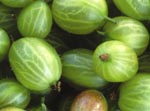Gardening diary December: Prune gooseberries
Leather gloves are required for pruning the gooseberry bush


If you want to buy any of the plants mentioned below for your own
garden, visit www.countrylife.co.uk/nursery and type or copy and paste
the name into the search. Plants are delivered in sturdy boxes in a
matter of days from one of the finest nurseries in the country.
The gooseberry is rather out of vogue at present, but that need not trouble those who love its interesting texture and flavour. It will rise again. It requires simple pruning. Firstly, understand that it should vaguely resemble a wine glass, with a short leg crowned by a rising ring of pale and slender shoots. Put on leather gloves and arm protection, and remove any shoots that don't conform to this neat ideal. Then, shorten this year's growth (you'll see) by half, leaving an outward-facing bud at each shoot tip. It takes longer than you might think, because of the prickles.
* Subscribe to Country Life and get our Ipad edition at no extra cost
Sign up for the Country Life Newsletter
Exquisite houses, the beauty of Nature, and how to get the most from your life, straight to your inbox.
Country Life is unlike any other magazine: the only glossy weekly on the newsstand and the only magazine that has been guest-edited by HRH The King not once, but twice. It is a celebration of modern rural life and all its diverse joys and pleasures — that was first published in Queen Victoria's Diamond Jubilee year. Our eclectic mixture of witty and informative content — from the most up-to-date property news and commentary and a coveted glimpse inside some of the UK's best houses and gardens, to gardening, the arts and interior design, written by experts in their field — still cannot be found in print or online, anywhere else.
-
 Vertigo at Victoria Falls, a sunset surrounded by lions and swimming in the Nile: A journey from Cape Town to Cairo
Vertigo at Victoria Falls, a sunset surrounded by lions and swimming in the Nile: A journey from Cape Town to CairoWhy do we travel and who inspires us to do so? Chris Wallace went in search of answers on his own epic journey the length of Africa.
By Christopher Wallace
-
 A gorgeous Scottish cottage with contemporary interiors on the bonny banks of the River Tay
A gorgeous Scottish cottage with contemporary interiors on the bonny banks of the River TayCarnliath on the edge of Strathtay is a delightful family home set in sensational scenery.
By James Fisher